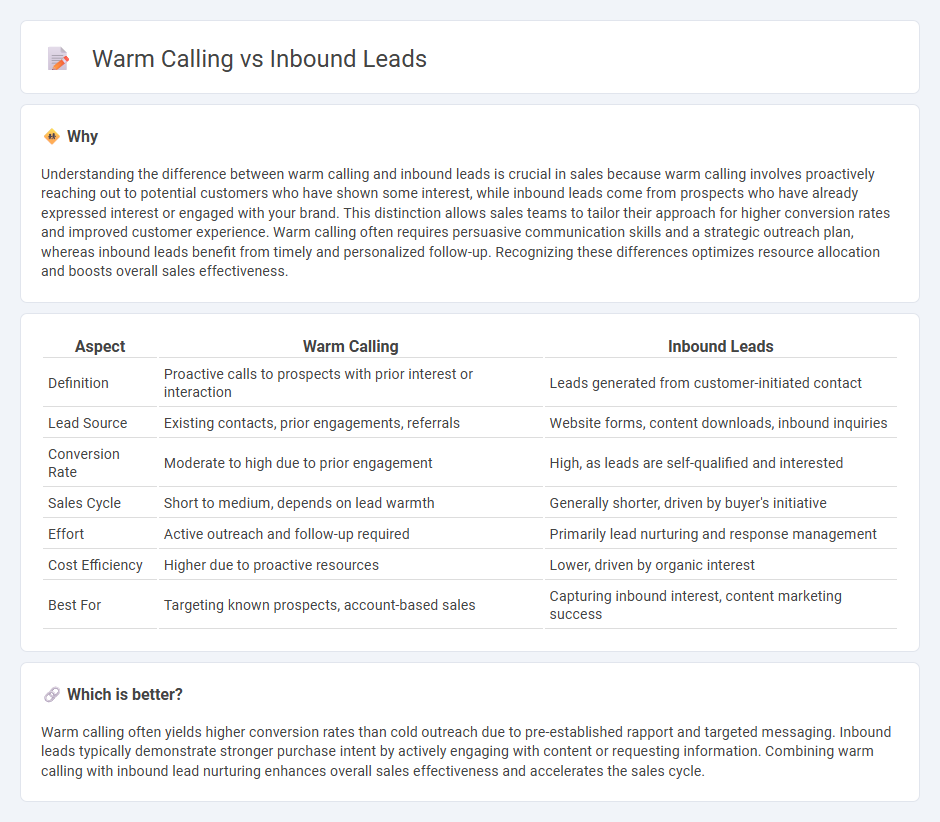
Warm calling targets prospects who have shown prior interest or engagement with a brand, increasing the likelihood of positive interactions and conversion rates. Inbound leads originate from potential customers actively seeking solutions, offering higher quality and readiness to purchase. Explore effective sales strategies by learning the key differences between warm calling and inbound lead approaches.
Why it is important
Understanding the difference between warm calling and inbound leads is crucial in sales because warm calling involves proactively reaching out to potential customers who have shown some interest, while inbound leads come from prospects who have already expressed interest or engaged with your brand. This distinction allows sales teams to tailor their approach for higher conversion rates and improved customer experience. Warm calling often requires persuasive communication skills and a strategic outreach plan, whereas inbound leads benefit from timely and personalized follow-up. Recognizing these differences optimizes resource allocation and boosts overall sales effectiveness.
Comparison Table
| Aspect | Warm Calling | Inbound Leads |
|---|---|---|
| Definition | Proactive calls to prospects with prior interest or interaction | Leads generated from customer-initiated contact |
| Lead Source | Existing contacts, prior engagements, referrals | Website forms, content downloads, inbound inquiries |
| Conversion Rate | Moderate to high due to prior engagement | High, as leads are self-qualified and interested |
| Sales Cycle | Short to medium, depends on lead warmth | Generally shorter, driven by buyer's initiative |
| Effort | Active outreach and follow-up required | Primarily lead nurturing and response management |
| Cost Efficiency | Higher due to proactive resources | Lower, driven by organic interest |
| Best For | Targeting known prospects, account-based sales | Capturing inbound interest, content marketing success |
Which is better?
Warm calling often yields higher conversion rates than cold outreach due to pre-established rapport and targeted messaging. Inbound leads typically demonstrate stronger purchase intent by actively engaging with content or requesting information. Combining warm calling with inbound lead nurturing enhances overall sales effectiveness and accelerates the sales cycle.
Connection
Warm calling leverages the interest generated by inbound leads, enhancing conversion rates through personalized follow-ups that address specific customer needs. Inbound leads provide valuable insights such as prior engagement history and expressed pain points, enabling sales teams to tailor their pitch effectively. This synergy streamlines the sales funnel, reduces cold outreach inefficiencies, and accelerates deal closures.
Key Terms
Lead Qualification
Inbound leads are prospects who initiate contact, showing a clear interest that often translates to higher lead qualification rates due to their self-identified needs. Warm calling targets leads with previous engagement or interest, allowing sales teams to tailor conversations based on existing data for improved qualification accuracy. Explore effective lead qualification strategies to optimize your sales pipeline outcomes.
Buyer Intent
Inbound leads demonstrate clear buyer intent through actions like website visits, content downloads, or request for quotes, indicating readiness to engage with sales. Warm calling targets prospects who have shown some interest but require personalized outreach to nurture their intent further. Explore detailed strategies to effectively harness buyer intent in both inbound leads and warm calling for higher conversion rates.
Conversion Rate
Inbound leads yield conversion rates up to 10-15% higher compared to warm calling, since they reflect active interest from potential customers seeking your product or service. Warm calling conversion rates typically range between 1-3%, since the outreach is unsolicited and relies on sparking interest in prospects. Explore strategies to improve conversion rates by understanding how to effectively nurture inbound leads versus optimizing warm calling techniques.
Source and External Links
Inbound Leads: Understand What, Why, and How - Leadfeeder - Inbound leads are prospects who initiate contact with a business, often classified as marketing qualified leads, product qualified leads, or sales qualified leads, and are especially valuable in B2B lead generation due to their readiness to enter the sales funnel.
What is Inbound Lead Generation? - Cognism - Managing inbound leads involves strategies such as lead scoring, CRM system usage, segmentation and personalisation, and prompt follow-up to convert prospects effectively and maximize ROI.
Inbound vs. Outbound Leads: What's the Difference? | Indeed.com - Inbound leads are sales leads that contact you first and passively pursue engagement, attracted through strategic campaigns often involving social media and search engine marketing, allowing the customer to control their interaction and timing.
 dowidth.com
dowidth.com